2023届高三英语二轮复习中国传统文化之艺术阅读训练-(无答案)
文档属性
| 名称 | 2023届高三英语二轮复习中国传统文化之艺术阅读训练-(无答案) | 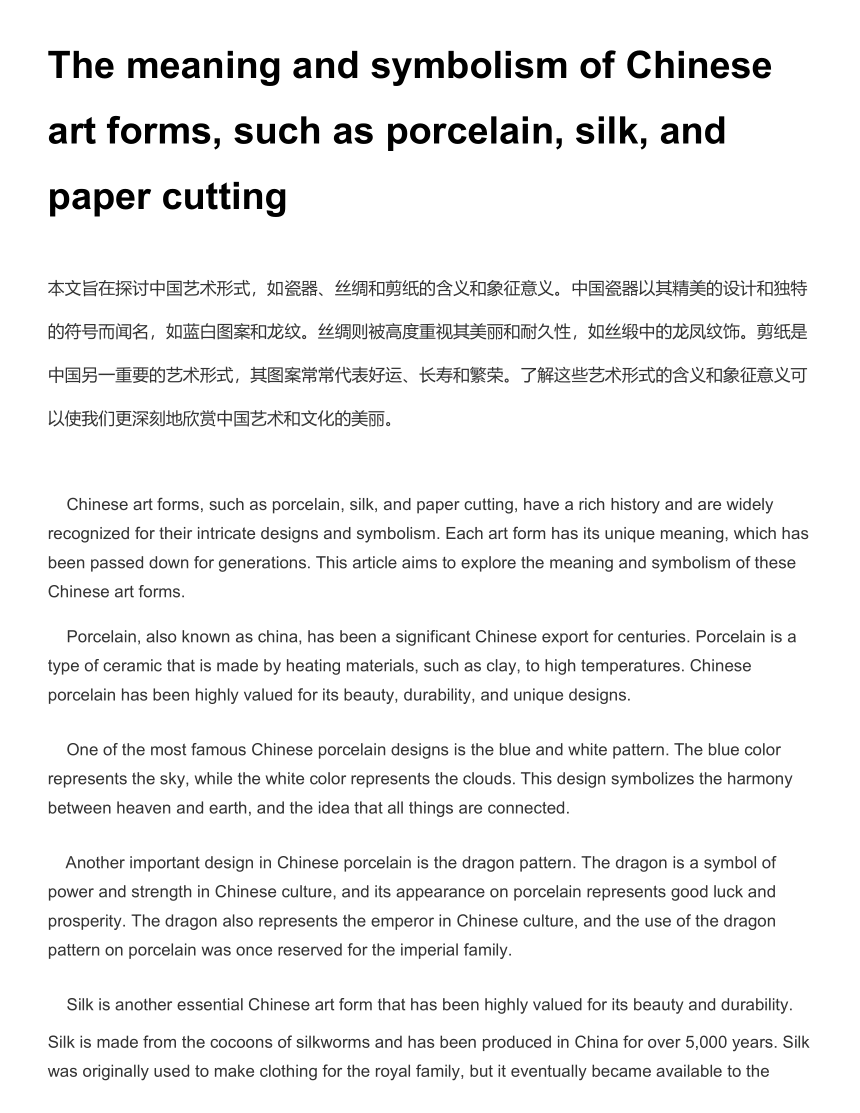 | |
| 格式 | docx | ||
| 文件大小 | 28.8KB | ||
| 资源类型 | 教案 | ||
| 版本资源 | 人教版(2019) | ||
| 科目 | 英语 | ||
| 更新时间 | 2023-02-20 12:01:11 | ||
图片预览

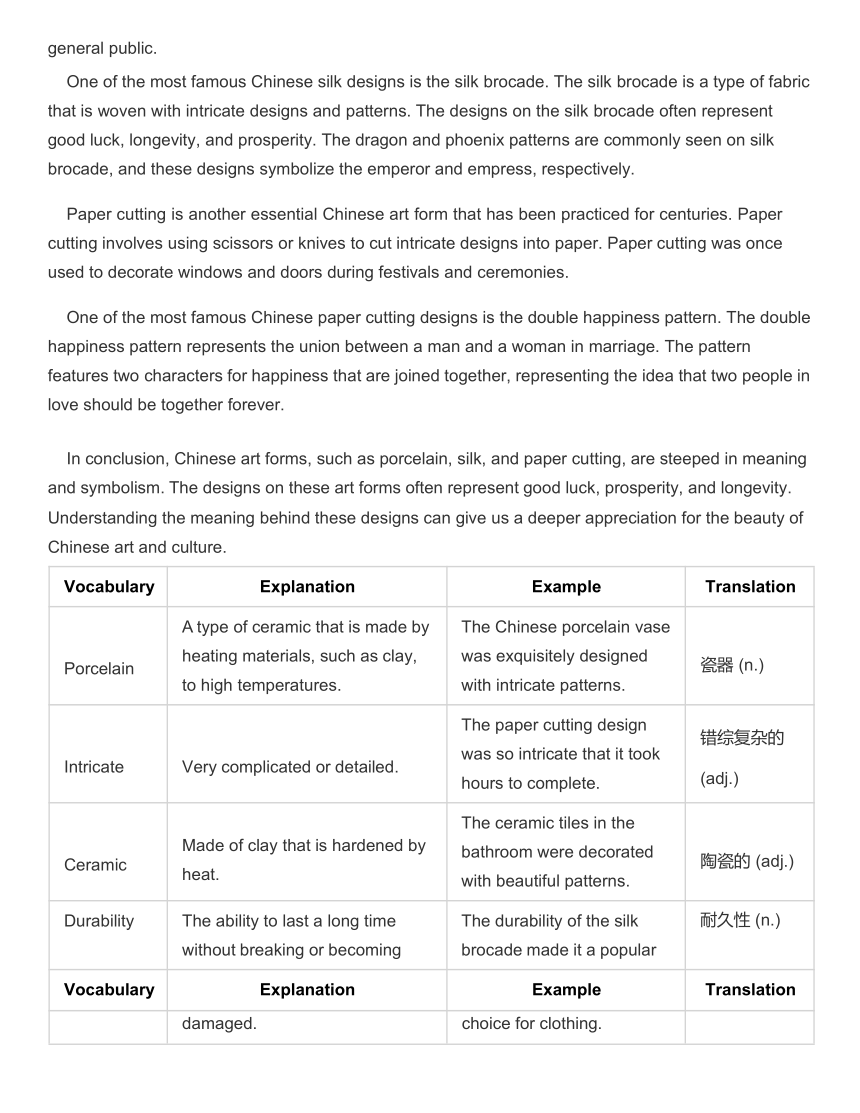
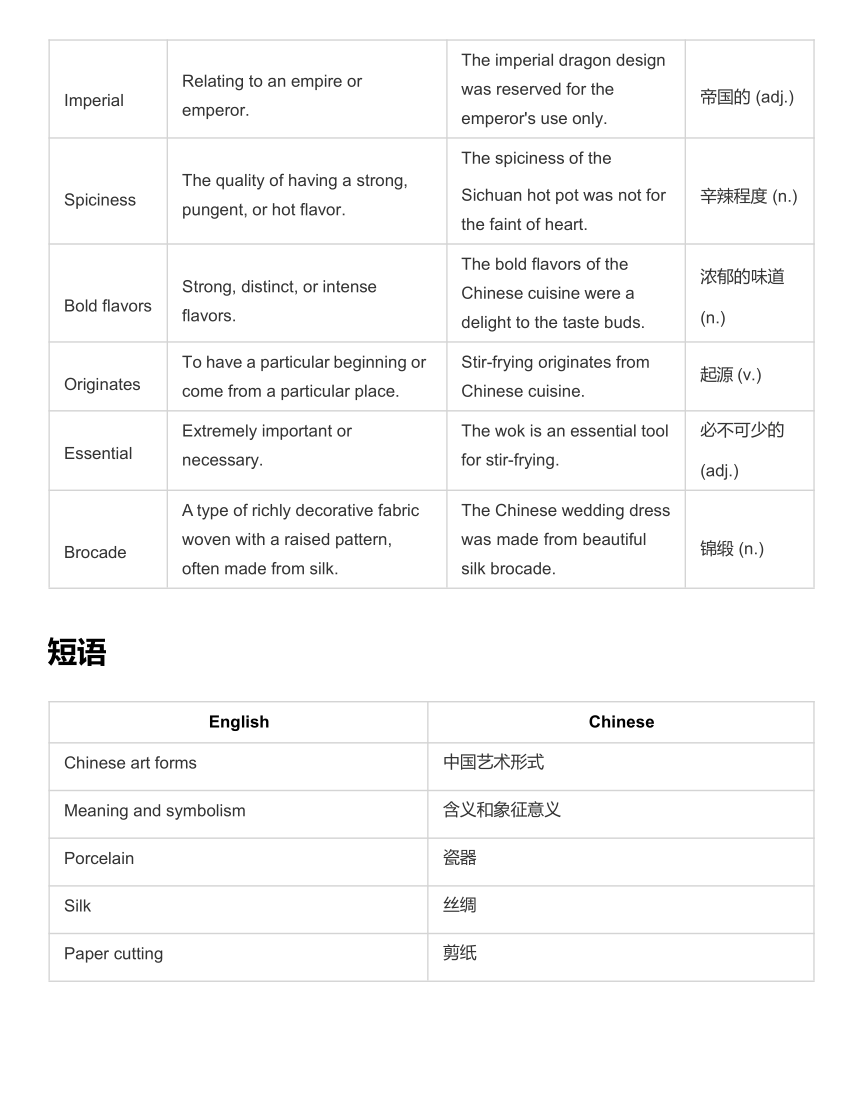
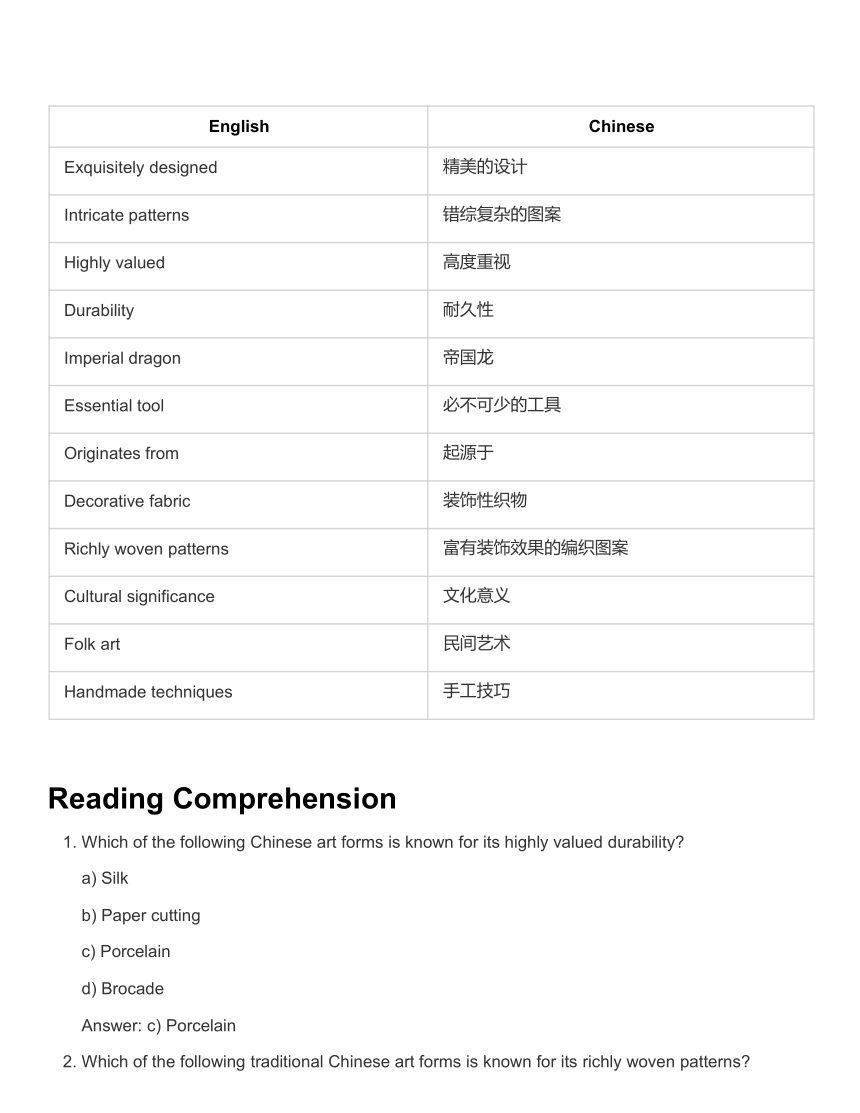
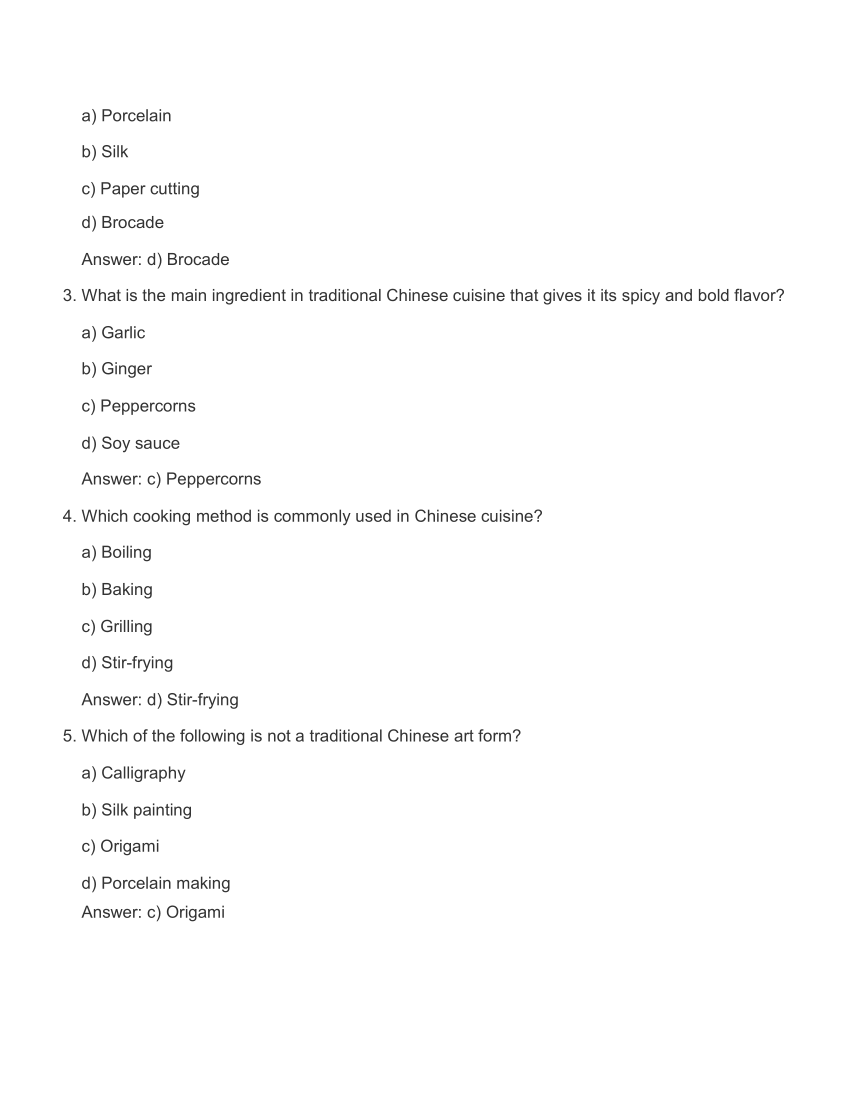
文档简介
The meaning and symbolism of Chinese art forms, such as porcelain, silk, and paper cutting
本文旨在探讨中国艺术形式,如瓷器、丝绸和剪纸的含义和象征意义。中国瓷器以其精美的设计和独特的符号而闻名,如蓝白图案和龙纹。丝绸则被高度重视其美丽和耐久性,如丝缎中的龙凤纹饰。剪纸是中国另一重要的艺术形式,其图案常常代表好运、长寿和繁荣。了解这些艺术形式的含义和象征意义可以使我们更深刻地欣赏中国艺术和文化的美丽。
Chinese art forms, such as porcelain, silk, and paper cutting, have a rich history and are widely recognized for their intricate designs and symbolism. Each art form has its unique meaning, which has been passed down for generations. This article aims to explore the meaning and symbolism of these Chinese art forms.
Porcelain, also known as china, has been a significant Chinese export for centuries. Porcelain is a type of ceramic that is made by heating materials, such as clay, to high temperatures. Chinese porcelain has been highly valued for its beauty, durability, and unique designs.
One of the most famous Chinese porcelain designs is the blue and white pattern. The blue color represents the sky, while the white color represents the clouds. This design symbolizes the harmony between heaven and earth, and the idea that all things are connected.
Another important design in Chinese porcelain is the dragon pattern. The dragon is a symbol of power and strength in Chinese culture, and its appearance on porcelain represents good luck and prosperity. The dragon also represents the emperor in Chinese culture, and the use of the dragon pattern on porcelain was once reserved for the imperial family.
Silk is another essential Chinese art form that has been highly valued for its beauty and durability.
Silk is made from the cocoons of silkworms and has been produced in China for over 5,000 years. Silk was originally used to make clothing for the royal family, but it eventually became available to the general public.
One of the most famous Chinese silk designs is the silk brocade. The silk brocade is a type of fabric that is woven with intricate designs and patterns. The designs on the silk brocade often represent good luck, longevity, and prosperity. The dragon and phoenix patterns are commonly seen on silk brocade, and these designs symbolize the emperor and empress, respectively.
Paper cutting is another essential Chinese art form that has been practiced for centuries. Paper cutting involves using scissors or knives to cut intricate designs into paper. Paper cutting was once used to decorate windows and doors during festivals and ceremonies.
One of the most famous Chinese paper cutting designs is the double happiness pattern. The double happiness pattern represents the union between a man and a woman in marriage. The pattern features two characters for happiness that are joined together, representing the idea that two people in love should be together forever.
In conclusion, Chinese art forms, such as porcelain, silk, and paper cutting, are steeped in meaning and symbolism. The designs on these art forms often represent good luck, prosperity, and longevity.
Understanding the meaning behind these designs can give us a deeper appreciation for the beauty of Chinese art and culture.
Vocabulary Explanation Example Translation
Porcelain A type of ceramic that is made by heating materials, such as clay, to high temperatures. The Chinese porcelain vase was exquisitely designed with intricate patterns. 瓷器 (n.)
Intricate Very complicated or detailed. The paper cutting design was so intricate that it took hours to complete. 错综复杂的 (adj.)
Ceramic Made of clay that is hardened by heat. The ceramic tiles in the bathroom were decorated with beautiful patterns. 陶瓷的 (adj.)
Durability The ability to last a long time without breaking or becoming The durability of the silk brocade made it a popular 耐久性 (n.)
Vocabulary Explanation Example Translation
damaged. choice for clothing.
Imperial Relating to an empire or emperor. The imperial dragon design was reserved for the emperor's use only. 帝国的 (adj.)
Spiciness The quality of having a strong, pungent, or hot flavor. The spiciness of the Sichuan hot pot was not for the faint of heart. 辛辣程度 (n.)
Bold flavors Strong, distinct, or intense flavors. The bold flavors of the Chinese cuisine were a delight to the taste buds. 浓郁的味道 (n.)
Originates To have a particular beginning or come from a particular place. Stir-frying originates from Chinese cuisine. 起源 (v.)
Essential Extremely important or necessary. The wok is an essential tool for stir-frying. 必不可少的 (adj.)
Brocade A type of richly decorative fabric woven with a raised pattern, often made from silk. The Chinese wedding dress was made from beautiful silk brocade. 锦缎 (n.)
短语
English Chinese
Chinese art forms 中国艺术形式
Meaning and symbolism 含义和象征意义
Porcelain 瓷器
Silk 丝绸
Paper cutting 剪纸
English Chinese
Exquisitely designed 精美的设计
Intricate patterns 错综复杂的图案
Highly valued 高度重视
Durability 耐久性
Imperial dragon 帝国龙
Essential tool 必不可少的工具
Originates from 起源于
Decorative fabric 装饰性织物
Richly woven patterns 富有装饰效果的编织图案
Cultural significance 文化意义
Folk art 民间艺术
Handmade techniques 手工技巧
Reading Comprehension
Which of the following Chinese art forms is known for its highly valued durability
Silk
Paper cutting
Porcelain
Brocade
Answer: c) Porcelain
Which of the following traditional Chinese art forms is known for its richly woven patterns
Porcelain
Silk
Paper cutting
Brocade
Answer: d) Brocade
What is the main ingredient in traditional Chinese cuisine that gives it its spicy and bold flavor
Garlic
Ginger
Peppercorns
Soy sauce
Answer: c) Peppercorns
Which cooking method is commonly used in Chinese cuisine
Boiling
Baking
Grilling
Stir-frying
Answer: d) Stir-frying
Which of the following is not a traditional Chinese art form
Calligraphy
Silk painting
Origami
Porcelain making Answer: c) Origami
Outline
Introduction
Brief overview of the significance of Chinese art forms
Explanation of the focus of the article on porcelain, silk, and paper cutting
Porcelain
History and origin of porcelain in China
Importance of porcelain in Chinese culture and symbolism
Symbolic meanings of specific colors and patterns in porcelain Examples of famous Chinese porcelain works
Silk
History and origin of silk production in China Importance of silk in Chinese culture and symbolism
Symbolic meanings of specific colors and patterns in silk Examples of famous Chinese silk works
Paper cutting
History and origin of paper cutting in China
Importance of paper cutting in Chinese culture and symbolism
Symbolic meanings of specific shapes and designs in paper cutting Examples of famous Chinese paper cutting works
Comparison and contrast of the three art forms
Commonalities and differences in symbolism and meaning Significance of the three art forms in Chinese culture
Conclusion
Recap of the significance and symbolism of Chinese art forms
Final thoughts on the importance of preserving and promoting these art forms.
Key Points
Porcelain is an important Chinese art form with a long history and rich symbolism.
Specific colors and patterns in porcelain have symbolic meanings in Chinese culture.
Silk is another significant Chinese art form with a long history and rich symbolism.
Specific colors and patterns in silk also have symbolic meanings in Chinese culture.
Paper cutting is a traditional Chinese folk art that has gained popularity and recognition.
Specific shapes and designs in paper cutting have symbolic meanings in Chinese culture.
Each of these art forms has its own unique symbolism and meaning, but they also share common themes and motifs.
These art forms have played an important role in Chinese culture and continue to be significant today.
It is important to preserve and promote these art forms to ensure that they continue to be a part of Chinese culture and heritage.
阅读训练
In the bustling city of Shanghai, there was a young artist named Lin who had a deep admiration for Chinese art forms. Growing up in a family that valued Chinese calligraphy, painting, and music, Lin
was exposed to the beauty and richness of these traditional arts from a young age. Her parents taught her how to play the guzheng, a traditional Chinese stringed instrument, and she spent countless hours practicing and perfecting her craft.
As Lin grew older, she realized that many young people in China were becoming disconnected from their cultural heritage. They were more interested in Western art forms and music, and were not as enthusiastic about traditional Chinese arts. This saddened Lin, who believed that Chinese art forms
were an essential part of China's identity and culture.
Determined to change this trend, Lin started a project to bring Chinese art forms into modern life. She started by designing modern clothing with traditional Chinese embroidery and patterns, which quickly gained popularity among young people. She then began collaborating with local musicians to create modern interpretations of traditional Chinese music, using electronic instruments and modern production techniques.
Lin's project soon gained a following, and she started receiving invitations to showcase her work at various cultural events and festivals. She even caught the attention of a local television station, who invited her to host a program that introduced Chinese art forms to a wider audience.
Thanks to Lin's dedication and hard work, Chinese art forms were becoming relevant and popular in modern society. People of all ages were starting to appreciate the beauty and significance of these traditional arts, and were incorporating them into their daily lives. Lin's project had successfully bridged the gap between tradition and modernity, and had helped preserve and promote China's cultural heritage for generations to come.
What inspired Lin to start her project
Her love of Western art forms
Her belief in the significance of Chinese art forms
Her desire for fame and fortune
Her parents' encouragement
Answer: b) Her belief in the significance of Chinese art forms
What was the first project that Lin started to bring Chinese art forms into modern life
Modern clothing with traditional Chinese embroidery
Modern music using traditional Chinese instruments
Calligraphy workshops for young people
Traditional Chinese puppetry performances
Answer: a) Modern clothing with traditional Chinese embroidery
How did Lin incorporate modern elements into traditional Chinese music
By using electronic instruments and modern production techniques
By adding Western-style lyrics to Chinese folk songs
By changing the tempo and rhythm of traditional Chinese music
By replacing traditional Chinese instruments with Western instruments Answer: a) By using electronic instruments and modern production techniques
What kind of program did Lin host on a local television station
A cooking show featuring traditional Chinese dishes
A talk show discussing current events in China
A program introducing Chinese art forms to a wider audience
A music show featuring Western and Chinese pop music
Answer: c) A program introducing Chinese art forms to a wider audience
What was the impact of Lin's project on Chinese society
It caused young people to lose interest in traditional Chinese arts
It created a divide between tradition and modernity
It helped preserve and promote China's cultural heritage
It led to the disappearance of traditional Chinese arts
Answer: c) It helped preserve and promote China's cultural heritage
本文旨在探讨中国艺术形式,如瓷器、丝绸和剪纸的含义和象征意义。中国瓷器以其精美的设计和独特的符号而闻名,如蓝白图案和龙纹。丝绸则被高度重视其美丽和耐久性,如丝缎中的龙凤纹饰。剪纸是中国另一重要的艺术形式,其图案常常代表好运、长寿和繁荣。了解这些艺术形式的含义和象征意义可以使我们更深刻地欣赏中国艺术和文化的美丽。
Chinese art forms, such as porcelain, silk, and paper cutting, have a rich history and are widely recognized for their intricate designs and symbolism. Each art form has its unique meaning, which has been passed down for generations. This article aims to explore the meaning and symbolism of these Chinese art forms.
Porcelain, also known as china, has been a significant Chinese export for centuries. Porcelain is a type of ceramic that is made by heating materials, such as clay, to high temperatures. Chinese porcelain has been highly valued for its beauty, durability, and unique designs.
One of the most famous Chinese porcelain designs is the blue and white pattern. The blue color represents the sky, while the white color represents the clouds. This design symbolizes the harmony between heaven and earth, and the idea that all things are connected.
Another important design in Chinese porcelain is the dragon pattern. The dragon is a symbol of power and strength in Chinese culture, and its appearance on porcelain represents good luck and prosperity. The dragon also represents the emperor in Chinese culture, and the use of the dragon pattern on porcelain was once reserved for the imperial family.
Silk is another essential Chinese art form that has been highly valued for its beauty and durability.
Silk is made from the cocoons of silkworms and has been produced in China for over 5,000 years. Silk was originally used to make clothing for the royal family, but it eventually became available to the general public.
One of the most famous Chinese silk designs is the silk brocade. The silk brocade is a type of fabric that is woven with intricate designs and patterns. The designs on the silk brocade often represent good luck, longevity, and prosperity. The dragon and phoenix patterns are commonly seen on silk brocade, and these designs symbolize the emperor and empress, respectively.
Paper cutting is another essential Chinese art form that has been practiced for centuries. Paper cutting involves using scissors or knives to cut intricate designs into paper. Paper cutting was once used to decorate windows and doors during festivals and ceremonies.
One of the most famous Chinese paper cutting designs is the double happiness pattern. The double happiness pattern represents the union between a man and a woman in marriage. The pattern features two characters for happiness that are joined together, representing the idea that two people in love should be together forever.
In conclusion, Chinese art forms, such as porcelain, silk, and paper cutting, are steeped in meaning and symbolism. The designs on these art forms often represent good luck, prosperity, and longevity.
Understanding the meaning behind these designs can give us a deeper appreciation for the beauty of Chinese art and culture.
Vocabulary Explanation Example Translation
Porcelain A type of ceramic that is made by heating materials, such as clay, to high temperatures. The Chinese porcelain vase was exquisitely designed with intricate patterns. 瓷器 (n.)
Intricate Very complicated or detailed. The paper cutting design was so intricate that it took hours to complete. 错综复杂的 (adj.)
Ceramic Made of clay that is hardened by heat. The ceramic tiles in the bathroom were decorated with beautiful patterns. 陶瓷的 (adj.)
Durability The ability to last a long time without breaking or becoming The durability of the silk brocade made it a popular 耐久性 (n.)
Vocabulary Explanation Example Translation
damaged. choice for clothing.
Imperial Relating to an empire or emperor. The imperial dragon design was reserved for the emperor's use only. 帝国的 (adj.)
Spiciness The quality of having a strong, pungent, or hot flavor. The spiciness of the Sichuan hot pot was not for the faint of heart. 辛辣程度 (n.)
Bold flavors Strong, distinct, or intense flavors. The bold flavors of the Chinese cuisine were a delight to the taste buds. 浓郁的味道 (n.)
Originates To have a particular beginning or come from a particular place. Stir-frying originates from Chinese cuisine. 起源 (v.)
Essential Extremely important or necessary. The wok is an essential tool for stir-frying. 必不可少的 (adj.)
Brocade A type of richly decorative fabric woven with a raised pattern, often made from silk. The Chinese wedding dress was made from beautiful silk brocade. 锦缎 (n.)
短语
English Chinese
Chinese art forms 中国艺术形式
Meaning and symbolism 含义和象征意义
Porcelain 瓷器
Silk 丝绸
Paper cutting 剪纸
English Chinese
Exquisitely designed 精美的设计
Intricate patterns 错综复杂的图案
Highly valued 高度重视
Durability 耐久性
Imperial dragon 帝国龙
Essential tool 必不可少的工具
Originates from 起源于
Decorative fabric 装饰性织物
Richly woven patterns 富有装饰效果的编织图案
Cultural significance 文化意义
Folk art 民间艺术
Handmade techniques 手工技巧
Reading Comprehension
Which of the following Chinese art forms is known for its highly valued durability
Silk
Paper cutting
Porcelain
Brocade
Answer: c) Porcelain
Which of the following traditional Chinese art forms is known for its richly woven patterns
Porcelain
Silk
Paper cutting
Brocade
Answer: d) Brocade
What is the main ingredient in traditional Chinese cuisine that gives it its spicy and bold flavor
Garlic
Ginger
Peppercorns
Soy sauce
Answer: c) Peppercorns
Which cooking method is commonly used in Chinese cuisine
Boiling
Baking
Grilling
Stir-frying
Answer: d) Stir-frying
Which of the following is not a traditional Chinese art form
Calligraphy
Silk painting
Origami
Porcelain making Answer: c) Origami
Outline
Introduction
Brief overview of the significance of Chinese art forms
Explanation of the focus of the article on porcelain, silk, and paper cutting
Porcelain
History and origin of porcelain in China
Importance of porcelain in Chinese culture and symbolism
Symbolic meanings of specific colors and patterns in porcelain Examples of famous Chinese porcelain works
Silk
History and origin of silk production in China Importance of silk in Chinese culture and symbolism
Symbolic meanings of specific colors and patterns in silk Examples of famous Chinese silk works
Paper cutting
History and origin of paper cutting in China
Importance of paper cutting in Chinese culture and symbolism
Symbolic meanings of specific shapes and designs in paper cutting Examples of famous Chinese paper cutting works
Comparison and contrast of the three art forms
Commonalities and differences in symbolism and meaning Significance of the three art forms in Chinese culture
Conclusion
Recap of the significance and symbolism of Chinese art forms
Final thoughts on the importance of preserving and promoting these art forms.
Key Points
Porcelain is an important Chinese art form with a long history and rich symbolism.
Specific colors and patterns in porcelain have symbolic meanings in Chinese culture.
Silk is another significant Chinese art form with a long history and rich symbolism.
Specific colors and patterns in silk also have symbolic meanings in Chinese culture.
Paper cutting is a traditional Chinese folk art that has gained popularity and recognition.
Specific shapes and designs in paper cutting have symbolic meanings in Chinese culture.
Each of these art forms has its own unique symbolism and meaning, but they also share common themes and motifs.
These art forms have played an important role in Chinese culture and continue to be significant today.
It is important to preserve and promote these art forms to ensure that they continue to be a part of Chinese culture and heritage.
阅读训练
In the bustling city of Shanghai, there was a young artist named Lin who had a deep admiration for Chinese art forms. Growing up in a family that valued Chinese calligraphy, painting, and music, Lin
was exposed to the beauty and richness of these traditional arts from a young age. Her parents taught her how to play the guzheng, a traditional Chinese stringed instrument, and she spent countless hours practicing and perfecting her craft.
As Lin grew older, she realized that many young people in China were becoming disconnected from their cultural heritage. They were more interested in Western art forms and music, and were not as enthusiastic about traditional Chinese arts. This saddened Lin, who believed that Chinese art forms
were an essential part of China's identity and culture.
Determined to change this trend, Lin started a project to bring Chinese art forms into modern life. She started by designing modern clothing with traditional Chinese embroidery and patterns, which quickly gained popularity among young people. She then began collaborating with local musicians to create modern interpretations of traditional Chinese music, using electronic instruments and modern production techniques.
Lin's project soon gained a following, and she started receiving invitations to showcase her work at various cultural events and festivals. She even caught the attention of a local television station, who invited her to host a program that introduced Chinese art forms to a wider audience.
Thanks to Lin's dedication and hard work, Chinese art forms were becoming relevant and popular in modern society. People of all ages were starting to appreciate the beauty and significance of these traditional arts, and were incorporating them into their daily lives. Lin's project had successfully bridged the gap between tradition and modernity, and had helped preserve and promote China's cultural heritage for generations to come.
What inspired Lin to start her project
Her love of Western art forms
Her belief in the significance of Chinese art forms
Her desire for fame and fortune
Her parents' encouragement
Answer: b) Her belief in the significance of Chinese art forms
What was the first project that Lin started to bring Chinese art forms into modern life
Modern clothing with traditional Chinese embroidery
Modern music using traditional Chinese instruments
Calligraphy workshops for young people
Traditional Chinese puppetry performances
Answer: a) Modern clothing with traditional Chinese embroidery
How did Lin incorporate modern elements into traditional Chinese music
By using electronic instruments and modern production techniques
By adding Western-style lyrics to Chinese folk songs
By changing the tempo and rhythm of traditional Chinese music
By replacing traditional Chinese instruments with Western instruments Answer: a) By using electronic instruments and modern production techniques
What kind of program did Lin host on a local television station
A cooking show featuring traditional Chinese dishes
A talk show discussing current events in China
A program introducing Chinese art forms to a wider audience
A music show featuring Western and Chinese pop music
Answer: c) A program introducing Chinese art forms to a wider audience
What was the impact of Lin's project on Chinese society
It caused young people to lose interest in traditional Chinese arts
It created a divide between tradition and modernity
It helped preserve and promote China's cultural heritage
It led to the disappearance of traditional Chinese arts
Answer: c) It helped preserve and promote China's cultural heritage
